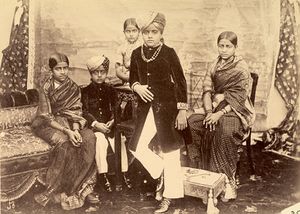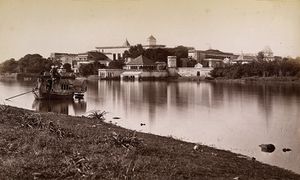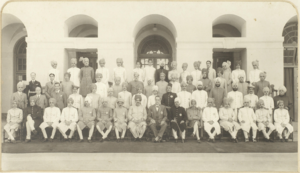ولاية أميرية
 | |||||
|---|---|---|---|---|---|
| مستعمرة الهند | |||||
| الهند الپرتغالية | 1505–1961 | ||||
| كازا دا إنديا | 1434–1833 | ||||
| شركة الهند الشرقية البرتغالية | 1628–1633 | ||||
| الهند الهولندية | 1605–1825 | ||||
| الهند الدنماركية | 1696–1869 | ||||
| الهند الفرنسية | 1759–1954 | ||||
| الإمبراطورية البريطانية في الهند | |||||
| شركة الهند الشرقية | 1612–1757 | ||||
| حكم الشركة في الهند | 1757–1857 | ||||
| الراج البريطاني | 1858–1947 | ||||
| الحكم البريطاني في بورما | 1826–1948 | ||||
| الهند البريطانية | 1612–1947 | ||||
| الولايات الأميرية | 1765–1947 | ||||
| تقسيم الهند | 1947 | ||||
| الولايات الأميرية |
|---|
| المقرات الفردية |
| الوكالات |
|
| قوائم |
الولاية الأميرية princely state، (تسمى أيضاً الولاية الأصلية (قانونياً) أو الولاية الهندية) كانت كيان يتمتع بسيادة اسمية[1] في فترة الراج البريطاني والتي لم تكن بريطانيا تحكمها بطريقة مباشرة، لكنها كان يحكمها حاكم محلي كإحدى أشكال الحكم غير المباشر،[2] وهو ما يجعلها عرضة للتحالف التابع وتخضع لهيمنة أو سلطة التاج البريطاني.
عند استقلالها عام 1947 كان هناك 565 ولاية أميرية رسمية في الهند، ولكن الأغلبية العظمى كانت قد عقدت اتفاقية فقط مع الحاكم العام للهند لتقديم الخدمات العامة وجمع الضرائب. ولم يكن يوجد سوى 21 ولاية كبرى فقط تتمتع بوجود حكومات حقيقية، ومن بينها أربع ولايات كبرى وهي (ولاية حيدر آباد وولاية ميسور وولاية جامو وكشمير وولاية بارودا). ثم انضمت هذه الولايات إلى إحدى الدولتين الحاصلتين على الاستقلال حديثًا في الفترة بين 1947 و1949. وقد اتسمت عملية الانضمام بالسلمية بوجه عام، باسثناء حالة جامو وكشمير (والتي شهدت انقسامًا مرًا بين الهند وپاكستان) وحيدر آباد. وفي النهاية أحيل جميع الأمراء للتقاعد.[3]
علاقة بريطانيا بالولايات الأميرية
تشكلت الهند في ظل الحكم البريطاني الهندي "الراج" ("الإمبراطورية الهندية") من نوعين من الولايات: الهندية البريطانية والولايات المحلية أو الولايات الأميرية. وفي قانون التفسير لعام 1889، اعتمد البرلمان البريطاني التعريفات التالية:
(4.) يشير التعبير "الهند البريطانية" إلى جميع الولايات والأماكن التي تقع تحت سيادة صاحبة الجلالة، والتي تحكمها في الوقت الحالي صاحبة الجلالة عن طريق الحاكم العام للهند أو من خلال أي حاكم أو مسؤول تابع للحاكم العام بالهند.
(5.) يشير التعبير "الهند" إلى الهند البريطانية وأي أراضٍ تقع تحت سيطرة الأمير المحلي أو الزعيم الخاضع لسلطة جلالتها التي يمارسها عنها الحاكم العام للهند، أو من خلال أي حاكم أو مسؤول تابع للحاكم العام بالهند.[4]
وبوجه عام، استخدم التعبير "الهند البريطانية" (ولا يزال مستخدمًا) ليشير إلى مناطق تقع تحت حكم شركة الهند الشرقية في الهند من عام 1774 وحتى 1858.[5][6] كما استخدم هذا التعبير للإشارة إلى الوجود "البريطاني في الهند".
وقد مورست سلطة التاج البريطاني على ما يزيد عن 175 ولاية أميرية، وكانت الولايات الأكبر والأكثر أهمية بوجه عام، وذلك باسم التاج البريطاني على يد الحومة المركزية للهند البريطانية وبواسطة الحاكم العام. أما باقي الولايات والتي تصل إلى حوالي أربعمائة ولاية، فقد وقعت تحت نفوذ مندوبين مسؤولين من حكومات المقاطعات البريطانية الهندية يخضعون جميعًا لحاكم، أو نائب حاكم، أو رئيس المفوضية.[7] وقد أوضحت السلطة القضائية للمحاكم القانونية الفرق بين "السيادة" و"السلطة": يعتمد قانون الهند البريطانية على التشريعات التي يمررها البرلمان البريطاني، والقوى التشريعية التي تمنحها هذه القوانين لحكومات الهند البريطانية، سواء أكانت مركزية أو محلية؛ وفي المقابل تقع محاكم الولايات الأميرية تحت سلطة حكام هذه الولايات.[7]
المركز والألقاب الأميرية

حمل الحكام الهنود ألقابًا متنوعة منها شاتراباتي (انحصر استخدام هذا اللقب على اثنين من البونسل في أسرة مراثا) أو باديشاه (Padishah) ("الإمبراطور")، ماهاراجا أو راجا ("الملك")، ونواب (Nawab)("الحاكم")، وثاكيور أو ثاكور (Thakur) ونظام (Nizam) ووالي (Wāli) وإنامدار(Inamdar)،[8] وسارانجامادر (Saranjamdar)[9] وكثير غيرها. وأيا كان المعنى الحرفي والمكانة التقليدية لللقب الذي ينخلع على الحاكم الهندي، فإن الحكومة البريطانية كانت تفسرها جميعًا بوصفها "أمير"، حتى تتجنب الإيحاء بأن يكون الحاكم المحلي "ملكًا" ذا مكانة مكافئة للتاج البريطاني.
أما الحكام الهنود ذوو الهيبة والمكانة (الذين وجدوا قبل الإمبراطورية المغولية، أو الذين انفصلوا عن الولايات القديمة)، فقد استخدموا عادة لقب "راجا" أو أحد مشتقاته مثل "رانا" أو "راو" أو "راوات" أو راوال. كما وجدت في هذه الطبقة عدة ثاكيور ساهيب (Thakur sahib) وعدة ألقاب خاصة مثل سار ديساي، (Sar Desai) أو راجا إنامدار (Raja Inamdar) أو سارانجامدار (Saranjamdar).
وعادة ما يحمل الحكام الهنود المرموقون البادئة "ماها" ("عظيم"، مقارنة بالدوق الأكبر، على سبيل المثال) في ألقابهم، كما في ماهاراجا، ماهارانا، ماهاراو، وما إلى ذلك. أما الولايات ترافنكور وكوتشي فقد كانت تحت حكم الملكات الحاكمات وكان يتم تلقيبهن بـ ماهاراني، كما يطلق هذا اللقب على الأخوات والزوجات والأرامل، اللائي كن يشغلن منصب الملكة الحاكمة.
كما توجد ألقاب مركبة، مثل (ماها)راجادهيراج (Maha)rajadhiraj))، وراجي-آي-راجان (Raj-i-rajgan)، والتي تعود عادة إلى نظام معقد من الألقاب تحت حكم الأباطرة المغول. فعلى سبيل، ترفع إضافة الصفة باهادور من مكانة حاملها مستوى أرفع.
وعلاوة على ذلك، فإن معظم الأسر الحاكمة استخدمت مجموعة متنوعة من الألقاب الإضافية، مثل فارما (Varma) في جنوب الهند. ولا يجب هنا الخلط بين الألقاب المتنوعة واللواحق غير المقتصرة على الأمراء، ولكنها تستخدم في جميع الطبقات (الأدنى مرتبة).
اعتمد أمراء السيخ في منطقة بنجاب الألقاب الهندية عند الحصول على المرتبة الأميرية؛ وعند المستوى الأدنى استُخدم اللقب ساردار (Sardar).
الأسبقية والهيبة




ولايات مدفع التحية
ولايات بلا مدفع تحية
سياسة انقضاء العهد
الحكومة الامبريالية

الولايات الأميرية الرئيسية عام 1947
لها علاقات مباشرة مع الحكومة المركزية
| اسم الولاية الأميرية | المساحة بالميل المربع | السكان عام 1941 | عائد الولاية (بالمائة ألف روپية) | لقب، عرقية ودين الحاكم | مدفع تحية الحاكم | تعيين المسئول السياسي المحلي |
|---|---|---|---|---|---|---|
| بارودا | 13,866 | 3,343,477 (غالبية هندوسية) | 323.26 | مهراجا، مراثا، هندوسي | 21 | المقيم في بارودا |
| حيدر أباد | 82,698 | 16,338,534 (غالبيتها من الهندوس مع أقلية كبيرة من المسلمين) | 1582.43 | نظام، توركي، سني مسلم | 21 | المقيم في حيدر أباد |
| جامو وكشمير | 84,471 | 4,021,616 تشمل الگيلگيت، البالتيسان (الشاردو)، اللاداك، والپونتش (غالبيتها من المسلمين، وأعداد كبيرة من الهندوس والبوذيين) | 463.95 | مهراجا، دوگرا، هندوسي | 21 | المقيم في جامو وكشمير |
| ميسور | 29,458 | 7,328,896 (غالبيتها من الهندوس) | 1001.38 | مهراجا، أراسو، هندوسي | 21 | المقيم في ميسور |
| گواليور | 26,397 | 4,006,159 (Chiefly Hindus) | 356.75 | مهراجا، ماراثا، هندوسي | 21 | المقيم في گواليور |
| الإجمالي | 236,890 | 35,038,682 | 3727.77 | |||
| من فضلك، إفرد الجداول لترى الوكالات تحت الحكومة المركزية | ||||||||||||||||||||||||||||||||||||||||||||||||||||||||||||||||||||||||||||||||||||||||||||||||||||||||||||||||||||||||||||||||||||||||||||||||||||||||||||||||||||||||||||||||||||||||||||||||||||
|---|---|---|---|---|---|---|---|---|---|---|---|---|---|---|---|---|---|---|---|---|---|---|---|---|---|---|---|---|---|---|---|---|---|---|---|---|---|---|---|---|---|---|---|---|---|---|---|---|---|---|---|---|---|---|---|---|---|---|---|---|---|---|---|---|---|---|---|---|---|---|---|---|---|---|---|---|---|---|---|---|---|---|---|---|---|---|---|---|---|---|---|---|---|---|---|---|---|---|---|---|---|---|---|---|---|---|---|---|---|---|---|---|---|---|---|---|---|---|---|---|---|---|---|---|---|---|---|---|---|---|---|---|---|---|---|---|---|---|---|---|---|---|---|---|---|---|---|---|---|---|---|---|---|---|---|---|---|---|---|---|---|---|---|---|---|---|---|---|---|---|---|---|---|---|---|---|---|---|---|---|---|---|---|---|---|---|---|---|---|---|---|---|---|---|---|---|
| ||||||||||||||||||||||||||||||||||||||||||||||||||||||||||||||||||||||||||||||||||||||||||||||||||||||||||||||||||||||||||||||||||||||||||||||||||||||||||||||||||||||||||||||||||||||||||||||||||||
| اسم الولاية الأميرية | المساحة بالميل المربع | السكان في 1941 | دخل الولاية (بالمائة ألف روپية) | لقب، عرقية، ودين الحاكم | تحية مدفع الحاكم | تعيين المسئول السياسي المحلي |
|---|---|---|---|---|---|---|
| سيكم | 2,818 | 121,520 (chiefly Buddhist and Hindu) | 5 | Maharaja, Tibetan, Buddhist | 15 | الضابط السياسي، سيكم |
- ولايات أخرى تحت الحكومات المحلية
| Please expand to view the tables for other states under Provincial Governments | |||||||||||||||||||||||||||||||||||||||||||||||||||||||||||||||||||||||||||||||||||||||||||||||||||||||||||||||||||||||||||||||||||||||||||||||||||||||||||||||||||||||||||||||||||||||||||||||||||||||||||||||||||||||||||||||||||||||
|---|---|---|---|---|---|---|---|---|---|---|---|---|---|---|---|---|---|---|---|---|---|---|---|---|---|---|---|---|---|---|---|---|---|---|---|---|---|---|---|---|---|---|---|---|---|---|---|---|---|---|---|---|---|---|---|---|---|---|---|---|---|---|---|---|---|---|---|---|---|---|---|---|---|---|---|---|---|---|---|---|---|---|---|---|---|---|---|---|---|---|---|---|---|---|---|---|---|---|---|---|---|---|---|---|---|---|---|---|---|---|---|---|---|---|---|---|---|---|---|---|---|---|---|---|---|---|---|---|---|---|---|---|---|---|---|---|---|---|---|---|---|---|---|---|---|---|---|---|---|---|---|---|---|---|---|---|---|---|---|---|---|---|---|---|---|---|---|---|---|---|---|---|---|---|---|---|---|---|---|---|---|---|---|---|---|---|---|---|---|---|---|---|---|---|---|---|---|---|---|---|---|---|---|---|---|---|---|---|---|---|---|---|---|---|---|---|---|---|---|---|---|---|---|---|---|---|---|---|---|---|---|
| |||||||||||||||||||||||||||||||||||||||||||||||||||||||||||||||||||||||||||||||||||||||||||||||||||||||||||||||||||||||||||||||||||||||||||||||||||||||||||||||||||||||||||||||||||||||||||||||||||||||||||||||||||||||||||||||||||||||
بورما
- Burma (52 States)
| اسم الولاية الأميرية | المساحة بالميل المربع | السكان عم 1901 | دخل الولاية (بالمائة ألف روپية) | لقب، عرقية، ودين الحاكم | تحية مدفع الحاكم | تعين المسئول السياسي المحلي |
|---|---|---|---|---|---|---|
| Hsipaw (Thibaw) | 5,086 | 105,000 (Buddhist) | 3 | Sawbwa, Shan, Buddhist | 9 | Superintendent, Northern Shan States |
| Kengtung | 12,000 | 190,000 (Buddhist) | 1 | Sawbwa, Shan, Buddhist | 9 | Superintendent Southern Shan States |
| Yawnghwe | 865 | 95,339 (Buddhist) | 2.13 | Sawbwa, Shan, Buddhist | 9 | Superintendent Southern Shan States |
| Mongnai | 2,717 | 44,000 (Buddhist) | 0.5 | Sawbwa, Shan, Buddhist | Superintendent Southern Shan States | |
| 5 Karenni States | 3,130 | 45,795 (Buddhist and Animist) | 0,035 | Sawbwa, Red Karen, Buddhist | Superintendent Southern Shan States | |
| 44 Other States | 42,198 | 792,152 (Buddhist and Animist) | 8.5 | |||
| Total | 67,011 | 1,177,987 | 13.5 | |||
القوات العسكرية للولاية
التكامل السياسي للولايات الأميرية عام 1947 وما بعدها
الهند (وسيكم)
پاكستان (وبنگلادش)
انظر أيضاً
- Salute state
- List of Indian Princely States for a list of Indian princely states at the time of Indian Independence
- List of Maratha dynasties and states
- List of Rajput dynasties and states
- قائم ملوك الهند
- Prince and Principality for information on princely styles worldwide
- ألقاب مراثا
- امبراطورية مراثا
- Rajputana
الهوامش
- ^ Ramusack 2004, pp. 85 Quote: "The British did not create the Indian princes. Before and during the European penetration of India, indigenous rulers achieved dominance through the military protection they provided to dependents and their skill in acquiring revenues to maintain their military and administrative organisations. Major Indian rulers exercised varying degrees and types of sovereign powers before they entered treaty relations with the British. What changed during the late eighteenth and early nineteenth centuries is that the British increasingly restricted the sovereignty of Indian rulers. The Company set boundaries; it extracted resources in the form of military personnel, subsidies or tribute payments, and the purchase of commercial goods at favourable prices, and limited opportunities for other alliances. From the 1810s onwards as the British expanded and consolidated their power, their centralised military despotism dramatically reduced the political options of Indian rulers." (p. 85)
- ^ Ramusack 2004, p. 87 Quote: "The British system of indirect rule over Indian states ... provided a model for the efficient use of scarce monetary and personnel resources that could be adopted to imperial acquisitions in Malaya and Africa. (p. 87)"
- ^ Wilhelm von Pochhammer, India's road to nationhood: a political history of the subcontinent (1981) ch 57
- ^ Interpretation Act 1889 (52 & 53 Vict. c. 63), s. 18
- ^ 1. Imperial Gazetteer of India, volume IV, published under the authority of the Secretary of State for India-in-Council, 1909, Oxford University Press. page 5. Quote: "The history of British India falls, as observed by Sir C. P. Ilbert in his Government of India, into three periods. From the beginning of the seventeenth century to the middle of the eighteenth century the East India Company is a trading corporation, existing on the sufferance of the native powers and in rivalry with the merchant companies of Holland and France. During the next century the Company acquires and consolidates its dominion, shares its sovereignty in increasing proportions with the Crown, and gradually loses its mercantile privileges and functions. After the mutiny of 1857 the remaining powers of the Company are transferred to the Crown, and then follows an era of peace in which India awakens to new life and progress." 2. The Statutes: From the Twentieth Year of King Henry the Third to the ... by Robert Harry Drayton, Statutes of the Realm – Law – 1770 Page 211 (3) "Save as otherwise expressly provided in this Act, the law of British India and of the several parts thereof existing immediately before the appointed ..." 3. Edney, M. E. (1997) Mapping an Empire: The Geographical Construction of British India, 1765–1843, University of Chicago Press. 480 pages. ISBN 978-0-226-18488-3 4. Hawes, C.J. (1996) Poor Relations: The Making of a Eurasian Community in British India, 1773–1833. Routledge, 217 pages. ISBN 0-7007-0425-6.
- ^ Imperial Gazetteer of India vol. II 1908, pp. 463, 470 Quote1: "Before passing on to the political history of British India, which properly begins with the Anglo-French Wars in the Carnatic, ... (p. 463)" Quote2: "The political history of the British in India begins in the eighteenth century with the French Wars in the Carnatic. (p.471)"
- ^ أ ب Imperial Gazetteer of India vol. IV 1907, p. 60
- ^ Great Britain. Indian Statutory Commission; Viscount John Allsebrook Simon Simon (1930). Report of the Indian Statutory Commission ... H.M. Stationery Office. Retrieved 9 June 2012.
- ^ All India reporter. D.V. Chitaley. 1938. Retrieved 9 June 2012.
- ^ أ ب Imperial Gazetteer of India vol. IV 1907, p. 92
- ^ "Mysore," Indian States and Agencies, The Statesman's Year Book 1947, pg 173, Macmillan & Co.
- ^ "Jammu and Kashmir," Indian States and Agencies, The Statesman's Year Book 1947, pg 171, Macmillan & Co.
- ^ "Hyderabad," Indian States and Agencies, The Statesman's Year Book 1947, pg 170, Macmillan & Co.
- ^ أ ب Imperial Gazetteer of India vol. IV 1907, p. 93
- ^ "Central India Agency," Indian States and Agencies, The Statesman's Year Book 1947, pg 168, Macmillan & Co.
- ^ "Eastern States," Indian States and Agencies, The Statesman's Year Book 1947, pg 168, Macmillan & Co.
- ^ "Gwalior Residency,", Indian States and Agencies, The Statesman's Year Book 1947, pg 170, Macmillan & Co.
- ^ Imperial Gazetteer of India vol. IV 1907, pp. 94–95
- ^ "Rajputana," Indian States and Agencies, The Statesman's Year Book 1947, pg 175, Macmillan & Co.
- ^ أ ب Imperial Gazetteer of India vol. IV 1907, p. 96
- ^ "Baluchistan States," Indian States and Agencies, The Statesman's Year Book 1947, pg 160, Macmillan & Co.
- ^ "Sikkim," Indian States and Agencies, The Statesman's Year Book 1947, pg 175, Macmillan & Co.
- ^ Imperial Gazetteer of India vol. IV 1907, p. 97
- ^ Imperial Gazetteer of India vol. IV 1907, p. 102
- ^ Imperial Gazetteer of India vol. IV 1907, p. 100
- ^ "Punjab States,", Indian States and Agencies, The Statesman's Year Book 1947, pg 174, Macmillan & Co.
- ^ Imperial Gazetteer of India vol. IV 1907, p. 103
- ^ "Assam States,", Indian States and Agencies, The Statesman's Year Book 1947, pg 160, Macmillan & Co.
- ^ Imperial Gazetteer of India vol. IV 1907, p. 101
المصادر
- Bhagavan, Manu. "Princely States and the Hindu Imaginary: Exploring the Cartography of Hindu Nationalism in Colonial India" Journal of Asian Studies, (Aug 2008) 67#3 pp 881–915 in JSTOR
- Copland, Ian (2002), Princes of India in the Endgame of Empire, 1917–1947, (Cambridge Studies in Indian History & Society). Cambridge and London: Cambridge University Press. Pp. 316, ISBN 0-521-89436-0, http://www.amazon.com/Princes-Endgame-19171947-Cambridge-Studies/dp/0521894360/.
- Harrington, Jack (2010), Sir John Malcolm and the Creation of British India, Chs. 4 & 5., New York: Palgrave Macmillan., ISBN 978-0-230-10885-1
- Jeffrey, Robin. People, Princes and Paramount Power: Society and Politics in the Indian Princely States (1979) 396pp
- Kooiman, Dick. Communalism and Indian Princely States: Travancore, Baroda & Hyderabad in the 1930s (2002), 249pp
- Markovits, Claude (2004). "ch 21: "Princely India (1858–1950)". A history of modern India, 1480–1950. Anthem Press. pp. 386–409. ISBN 978-1-84331-152-2.
- Ramusack, Barbara (2004), The Indian Princes and their States (The New Cambridge History of India), Cambridge and London: Cambridge University Press. Pp. 324, ISBN 0-521-03989-4, http://www.amazon.com/Indian-Princes-States-Cambridge-History/dp/0521267277
- Pochhammer, Wilhelm von India's Road to Nationhood: A Political History of the Subcontinent (1973) ch 57 excerpt
معاجم
- Imperial Gazetteer of India vol. II (1908), The Indian Empire, Historical, Published under the authority of His Majesty's Secretary of State for India in Council, Oxford at the Clarendon Press. Pp. xxxv, 1 map, 573. online
- Imperial Gazetteer of India vol. III (1907), The Indian Empire, Economic (Chapter X: Famine, pp. 475–502, Published under the authority of His Majesty's Secretary of State for India in Council, Oxford at the Clarendon Press. Pp. xxxvi, 1 map, 520. online
- Imperial Gazetteer of India vol. IV (1907), The Indian Empire, Administrative, Published under the authority of His Majesty's Secretary of State for India in Council, Oxford at the Clarendon Press. Pp. xxx, 1 map, 552. online
وصلات خارجية
- Indian Princely states and their History and detailed Genealogy – Royalark
- Sir Roper Lethbridge (1893). The Golden Book of India: A Genealogical and Biographical Dictionary of the Ruling Princes, Chiefs, Nobles, and Other Personages, Titled or Decorated, of the Indian Empire (Full text). Macmillan And Co., New York.
- Exhaustive lists of rulers and heads of government, and some biographies.
